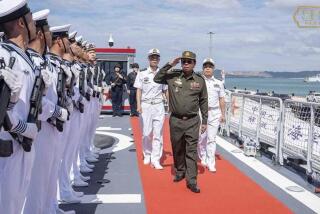Isolated Outpost in Cuba
- Share via
GUANTANAMO BAY NAVAL BASE, Cuba — Most cigars sold here are Jamaican. Spanish is rarely spoken. Small U.S. flags adorn the antennas of Chevrolet pickups. The music blaring has a distinctly American beat.
The Guantanamo Bay naval base is part of Cuba only geographically speaking. Enclosed in 17 miles of fence guarded by U.S. Marines, it is firmly isolated from the land beyond.
Few people come or go under the sign that declares in Spanish, “Republic of Cuba: Free Territory of America,” and coils of rusted concertina wire remain as a reminder of political differences that have divided two nations for more than four decades.
Few traces of Cuba remain on the base except for about 70 Cubans who live here--a mix of longtime residents, their descendants, and asylum-seekers who swam or crossed minefields to reach the U.S. outpost.
“We all know each other,” said Gloria Martinez, a 69-year-old widow who has lived on the base since 1961, when she and her husband sought refuge after the triumph of Fidel Castro’s communist revolution.
Martinez has become a U.S. citizen and speaks English, but she prefers Spanish and enjoys cooking Cuban dishes of pork, black beans and rice for friends. “Here, I have a big family,” she said.
But for nearly all the 4,700 military personnel and civilians here, free time means paintball tournaments, yoga classes and dancing to hip-hop tunes at the recreation hall.
“It feels like I’m just in another place in America,” said Lance Cpl. Joshua Devore, a 21-year-old Marine from Rochester, N.Y., who helps guard prisoners accused of having links to Afghanistan’s fallen Taliban regime or the Al Qaeda terrorist network.
The base has no stoplights, and some say it feels like a small American town of the 1950s. The weekly newsletter announces a military spouse apron sale and each day’s school lunch, from fish sticks to fruit gelatin.
The base closed its gates to Cuba in 1961 after the failed CIA-backed invasion by anti-Castro Cubans at the Bay of Pigs. The only people allowed through nowadays are 10 elderly Cuban workers who arrive at the gates by bus each morning--the last among thousands who once commuted to jobs here. The youngest among them is 62.
In many ways, the base is an island within an island, a sort of modern-day Alcatraz, which like the now-closed prison off San Francisco has become useful because of its isolation.
Defense Secretary Donald H. Rumsfeld called it “the least worst place we could have selected” for the captives from the Afghanistan war.
Radios on the base pick up Cuba’s Radio Reloj on the AM dial, and at night the lights of the nearby towns Caimanera and Boqueron cast their glow from below the horizon.
But the U.S. trade embargo prevents buying Cuban cigars or anything else from the other side. It’s also impossible to telephone Cuba directly.
Normal channels of communication were cut long ago. U.S. troops seized the land in 1898 during the Spanish-American War, and since a 1903 agreement, the United States has leased it from Cuba for 2,000 gold coins a year, now valued at $4,085.
The U.S. government still pays, but Castro’s government opposes the U.S. presence and refuses to cash the checks. Since 1964, when Cuba cut the water supply, the base has drawn its water from a desalination plant.
With the end of the Cold War, tensions have eased. Along the fence, Marines in guard towers watch Cuban guards in distant lookout posts. Now and then, a thump from the explosion of an old Cuban landmine breaks the silence, set off by a passing animal or perhaps just age.
Cubans from the nearby city of Guantanamo still occasionally swim across the bay or hike to the base in hopes of taking refuge. But the number of asylum-seekers has waned, and now most are sent back as required by a 1995 migration agreement.
A small number who can prove a fear of political persecution are allowed to stay until U.S. officials find other countries to accept them. Those 25 Cubans live in separate barracks, and some have remained for years.
In the mid-1990s, the base held tens of thousands of Cuban and Haitian boat people picked up by U.S. ships as they tried to get to the U.S. mainland. Most of the Cubans were admitted into the United States; most Haitians were sent home. The last of the Cubans departed in 1996, leaving empty camps on the dry, cactus-dotted hills.
Near a seaside cliff, one Cuban artist left a sculpture of a woman, her gaze fixed in the distance--a silent reminder that this place too is part of Cuba.
Once a month, U.S. and Cuban officers meet at the gates to discuss security issues. Relations between their governments, though, remain cool.
“Someday maybe they’ll open up the gates and let us down in Guantanamo City,” said Army 2nd Lt. Jason Miller of Bettendorf, Iowa. “But not until the United States and Cuba mend fences.”
More to Read
Sign up for Essential California
The most important California stories and recommendations in your inbox every morning.
You may occasionally receive promotional content from the Los Angeles Times.










